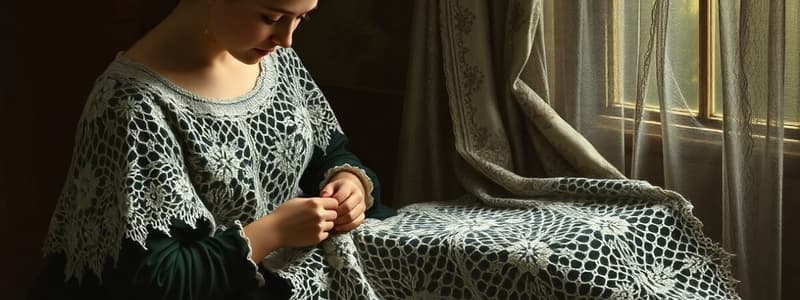Podcast
Questions and Answers
What was the primary economic activity of tenant farmers in Ireland during the 1800s?
What was the primary economic activity of tenant farmers in Ireland during the 1800s?
- Operating small businesses in urban centers.
- Trading goods with other European countries.
- Cultivating crops on land owned by wealthy Irish lords. (correct)
- Manufacturing Irish lace for export to England.
How did the potato blight of 1845-1851 directly impact the Irish tenant farmers?
How did the potato blight of 1845-1851 directly impact the Irish tenant farmers?
- It resulted in the redistribution of land from wealthy lords to the tenant farmers.
- It caused widespread crop destruction and starvation among the tenant farmers. (correct)
- It led to an increase in lace production as families sought alternative income sources.
- It forced the tenant farmers to diversify into raising livestock.
What role did Catholic nuns play in the development of Irish lace?
What role did Catholic nuns play in the development of Irish lace?
- They boycotted the use of Irish lace to promote simpler fashions.
- They created schools to teach lace-making skills as a means to alleviate poverty. (correct)
- They established factories for mass-producing Irish lace.
- They lobbied the British government to protect the Irish lace industry.
How did families protect the originality of their Irish lace designs?
How did families protect the originality of their Irish lace designs?
What factors contributed to the decline of the crochet schools established by nuns in the mid-19th century?
What factors contributed to the decline of the crochet schools established by nuns in the mid-19th century?
How did factory production impact the manufacturing of Irish lace?
How did factory production impact the manufacturing of Irish lace?
What does the term 'lace curtain Irish' refer to and what relevance does it have to the Irish lace industry?
What does the term 'lace curtain Irish' refer to and what relevance does it have to the Irish lace industry?
What was the significance of the 1880s in the context of Irish lace production?
What was the significance of the 1880s in the context of Irish lace production?
How did the economic structure of 1800s Ireland contribute to the development of the Irish lace industry?
How did the economic structure of 1800s Ireland contribute to the development of the Irish lace industry?
How did the tradition of Irish lace-making contribute to the preservation of Irish cultural heritage?
How did the tradition of Irish lace-making contribute to the preservation of Irish cultural heritage?
Flashcards
Irish Lace
Irish Lace
Intricate designs made from simple patterns, initially produced as a cottage industry in Ireland.
Crofts
Crofts
Small plots of land in Ireland where tenant farmers lived and produced crops for wealthy Irish lords.
Tenant Farmers
Tenant Farmers
Farmers who lived on and farmed land owned by wealthy Irish lords, producing crops for them.
Potatoes in Ireland
Potatoes in Ireland
Signup and view all the flashcards
Nuns & Irish Lace
Nuns & Irish Lace
Signup and view all the flashcards
Lace Curtain Irish
Lace Curtain Irish
Signup and view all the flashcards
Study Notes
- Irish lace is known for its intricate designs derived from simple patterns.
- Modern lace-making is a large-scale factory business.
- Irish lace originally began as a cottage industry.
1800s Ireland
- Ireland was divided socioeconomically between the rich and poor during this time.
- Many families lived in small cottages on small plots of land called crofts.
- Wealthy Irish lords owned the land.
- Tenant farmers farmed the land for the lords.
- Tenant farmers usually grew some of their own food on land not used for the main crops.
- Most tenant farmers were very poor.
Potato Blight
- Tenant farmers found potatoes to be a reliable crop.
- Potatoes became the staple crop on the crofts.
- A potato blight occurred between 1845 and 1851.
- Massive crop destruction occurred, and thousands of people starved as a result.
Relief from the Famine
- Relief came to Irish families via Catholic nuns familiar with Venetian lace-making.
- Irish women traditionally produced rough cloth for their families.
- Nuns realized lace-making skills could help people survive the famine.
- Schools were established to teach girls and women to make crochet, which became known as Irish lace.
- Wealthier families who could afford to buy the lace were nicknamed "lace curtain Irish".
Irish Lace Design
- Lace designs consisted of detailed patterns developed by individual families.
- Patterns were closely guarded secrets passed from mother to daughter, preserving originality.
- Pattern details were kept so secret that many were lost if families died or fled due to poverty.
Decline and Revival
- Crochet schools established by nuns disappeared in the 1850s and 1860s.
- Fashions changed, decreasing the demand for Irish lace.
- Factory production was introduced, changing the industry, and mass production became the norm.
- A brief revival of the cottage lace industry occurred in the 1880s.
- Most of the lace samples from this time are now family heirlooms or museum pieces.
Studying That Suits You
Use AI to generate personalized quizzes and flashcards to suit your learning preferences.




